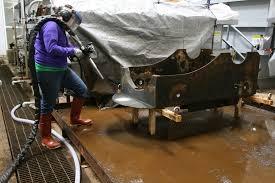How Dry Ice Blasting Works and Why It Matters
Cleaning is an important part of almost every industry. Whether it’s keeping machines running smoothly, making buildings look new again, or preparing surfaces for painting, the way we clean matters. One method that is quickly becoming more popular is dry ice blasting — a fast, clean, and safe way to remove dirt and unwanted materials using the freezing power of dry ice.
Let’s take a closer look at what dry ice blasting is, how it works, where it’s used, and why it’s such a smart cleaning choice.
What is dry ice?
Dry ice is not made of water like regular ice. Instead, it is made from carbon dioxide (CO₂) that has been frozen into a solid form. It is extremely cold — around minus 78 degrees Celsius — and it has a special feature: it doesn’t melt into a liquid. Instead, it turns directly from a solid into a gas. This process is called sublimation.
This is what makes dry ice perfect for cleaning. It disappears after use, leaving no water or chemical mess behind.
What is dry ice blasting?
Dry ice blasting is a method of cleaning that uses small dry ice pellets. These pellets are shot out of a special machine at high speed, using compressed air. When the pellets hit a dirty surface, they quickly freeze the material, making it brittle and easy to break off. At the same time, the dry ice turns into gas and expands, helping push the dirt or coating off the surface.
There’s no need for water, soap, or sand. And because the dry ice disappears, cleanup is much easier than with other cleaning methods.
How does it clean without damaging the surface?
The secret of dry ice blasting is in the combination of cold, speed, and gas. Here’s how it works in three simple steps:
- The dry ice pellets hit the surface and break up the dirt through impact.
- The extreme cold freezes the unwanted material, making it crack and lose its grip.
- The dry ice turns into carbon dioxide gas, which expands and lifts the loosened material off the surface.
Since the dry ice itself is soft and not abrasive, it won’t scratch or harm most surfaces. This makes it useful for cleaning everything from metal machines to old brick walls.
Where is dry ice blasting used?
Dry ice blasting is useful in many industries. Here are just a few common examples:
- Food processing plants: Clean equipment without using water or chemicals.
- Automotive repair: Remove oil, grease, and paint from engines and parts.
- Electronics: Clean electric panels and delicate components safely.
- Fire and mold restoration: Remove smoke stains and mold from walls and ceilings.
- Factories and production lines: Clean machines without stopping work.
- Historic buildings: Gently clean stone, brick, and wood without damage.
Because it’s non-toxic and safe for many surfaces, it’s often the best choice for sensitive jobs.
Benefits of dry ice blasting
There are many reasons why companies choose dry ice blasting over traditional cleaning:
- It’s completely dry — no water, no moisture.
- No need for harsh chemicals or cleaning products.
- It’s safe for the environment and leaves no waste behind.
- It does not damage the surface being cleaned.
- Machines often don’t need to be turned off or taken apart.
- It saves time, effort, and reduces downtime in industrial settings.
For companies that care about safety, the environment, and efficiency, dry ice blasting is a smart and modern option.
What are the limitations?
Even though dry ice blasting is very useful, it does have a few limits:
- It requires special equipment and trained workers.
- It may cost more than simple cleaning methods for small jobs.
- It must be done in a well-ventilated area, because carbon dioxide gas can build up in closed spaces.
- It may not work well on soft or sticky materials that need to be scrubbed off.
Despite these limitations, it is often the best choice when fast, safe, and dry cleaning is needed.
Is it safe?
Yes, dry ice blasting is safe when done correctly. Because dry ice is extremely cold, workers must wear gloves and eye protection. Hearing protection is also recommended because the machines can be noisy. Good ventilation is also important to keep the air safe to breathe, especially in small spaces.
With the right safety steps, dry ice blasting is one of the cleanest and safest ways to handle tough cleaning jobs.
Final thoughts
Dry ice blasting is changing the way people think about cleaning. It’s fast, dry, gentle on surfaces, and better for the environment. From car engines to food factories to old buildings, this modern cleaning method is proving to be both powerful and practical.
As industries continue to look for smarter, greener ways to work, dry ice blasting is showing that sometimes, the coolest way to clean is also the best.

